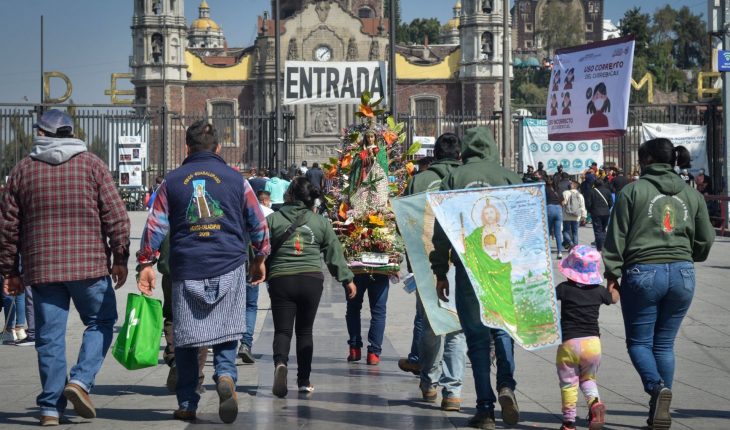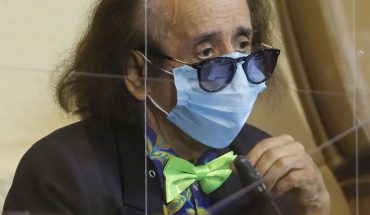Mexico pays tribute this Sunday to its patron saint, the Virgin of Guadalupe, with one of the largest Catholic pilgrimages in the world, after other massive events that challenge the risks of a rebound of the pandemic in a country that keeps its borders open.
It is expected that since last Friday and until this Sunday 4.2 million people have come to the Basilica of Guadalupe, in the north of Mexico City, compared to 11 million in 2019, to resume a cult suspended last year by covid.
You may be interested in: Basilica of Guadalupe: schedules, measures, restrictions and what you need to know
With mandatory use of masks and disinfectant gel, the virus has forced to modify a little the ritual that began 490 years ago when, according to tradition, the Virgin appeared to the indigenous Juan Diego on the hill of Tepeyac.
The faithful of the “Virgen Morena” must present a “complete vaccination scheme”, which according to the government already has 65.6 million people in this country of 126 million inhabitants.
They are also asked not to come with children or adolescents who have not been vaccinated, nor can they camp – as used to be customary – to sing “Las Mañanitas” to the patron saint, or stay too long inside the sanctuary.
The Masses, meanwhile, were replaced by pre-recorded sermons that aired Saturday on YouTube.
Catholics make up 70% of the Mexican population, according to official figures.
The pilgrimage marks the beginning of the end of the year celebrations, which will last until Three Kings Day in early January, without special restrictions despite the fact that this Saturday 235 new deaths and 2,655 covid infections were reported.
In total, Mexico accumulates 296 thousand 620 deaths and 3 million 917 thousand 361 confirmed cases since March 2020.
The devotion to the Virgin of Guadalupe in Mexico is such that leftist President Andrés Manuel López Obrador, who declares himself a Christian but not a Catholic, suspended his public agenda this Sunday. “We have to be respectful,” he said.
“The people of Mexico are Guadalupano (…). Its two main symbols are the Virgin of Guadalupe, firstly, and secondly (former president) Benito Juárez (1858-1872),” he said on Saturday.
Contrary to the panic in many parts of the world, Mexico City has not taken any particular action following the announcement, on December 3, of a first case of the ómicron variant in its territory.
The seventh most visited country in the world remains one of the few whose “borders remain open to travelers,” as its embassy websites indicate.
Except for filling out a health questionnaire, the Mexican government “does not impose any restrictions related to the pandemic or obligation to present a negative PCR test to take a flight to Mexico.”
“Closing the borders and blocking people or goods are not useful measures to contain the variants,” repeats Hugo López-Gatell, undersecretary of Health and spokesman for the pandemic.
López-Gatell relies on vaccination “to reduce the risks of hospitalization and death.”
The administration of booster doses to those over 60 also began this week, with López Obrador at the helm.
A total of 27 of Mexico’s 32 states remain at “green traffic lights,” an index of low epidemiological risk that does not imply any particular restriction, apart from the recommendation to wear a mask, wash hands frequently and maintain a “healthy distance” (1.5 meters between individuals in public places).
Thus, after months of “red lights”, the massive outdoor gatherings have happened for a month and a half: parade for the Day of the Dead in early November, Formula 1 Grand Prix, Guadalajara International Book Fair, speech of the president before tens of thousands of people on December 1.
Likewise, the first leg of the final of the football championship between León and Atlas was played in front of 23,500 people on Thursday night.
Read more: Gallery: the Basilica of Guadalupe, empty for the first time on December 12
Mexico City has also revived the “Sonideros”, neighborhood DJ’s that animate popular festivals.
“It’s a traveling disco in your street, which fills up like you can’t imagine,” says Mario Alberto Linares, a “sonidero” who put the inhabitants of Ciudad Lago, a district in the north of the capital, to dance last Saturday.
Only the prospect of a rebound of the virus hinders his joy a little: “We are starting to feel bad vibes. I feel like they will let us work until January and then lock us up. I hope not, but we heard rumors.”
What we do at Animal Político requires professional journalists, teamwork, maintaining dialogue with readers and something very important.: independence. You can help us keep going. Be part of the team.
Subscribe to Animal Político, receive benefits and support free journalism.#YoSoyAnimal





